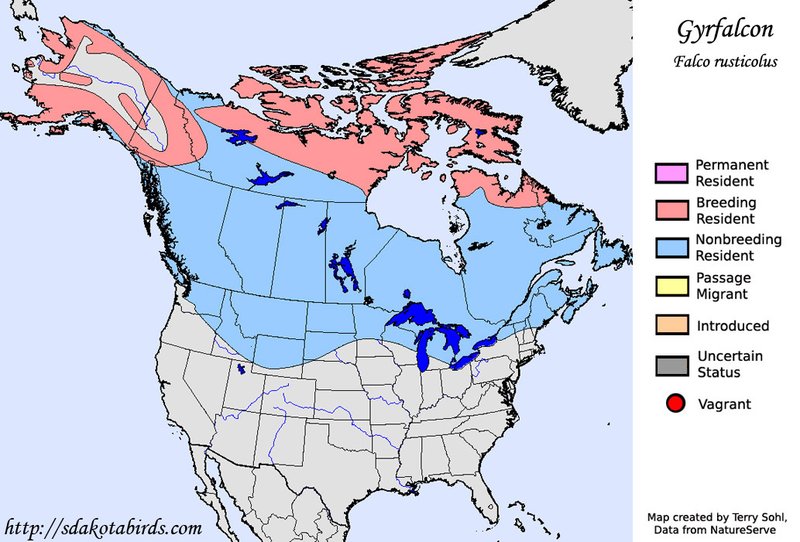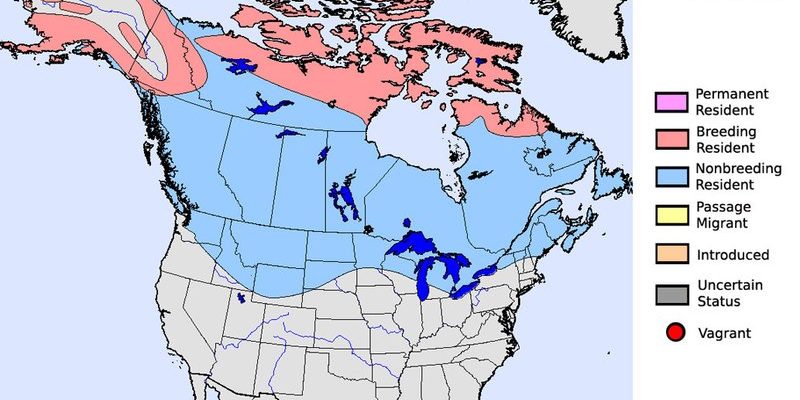
Just like how a fish thrives in water, gyrfalcons have specific environments that suit their needs. They’re not your average backyard birds; these feathered hunters prefer the chilly, open spaces of the Arctic and sub-Arctic regions. So, let’s dive into where you’ll find them and what makes their homes so special.
Gyrfalcon Range: An Overview
Gyrfalcons are predominantly found across the northern hemisphere. Their range extends from North America to Europe and Asia, making them quite the global wanderers in the avian world.
In North America, they can be spotted mainly in Alaska and parts of Canada. Their presence in Greenland is significant, as this is one of their strongholds. Over in Europe, they inhabit Iceland and northern Scandinavia, while in Asia, they grace the landscapes of Siberia and northern Russia.
These birds typically migrate based on the availability of food. During winter, they may move southward or to lower altitudes, seeking out areas where prey is more abundant. So, if you happen to be in these regions, keep your eyes peeled—you might just catch a glimpse of a gyrfalcon in its natural habitat.
Ideal Habitats for Gyrfalcons
The ideal habitat for gyrfalcons is primarily characterized by open terrain. They thrive in environments like tundra, mountains, and coastlines. These locations provide them with vast areas to hunt and ample nesting sites on cliffs or rocky outcroppings.
Gyrfalcons prefer areas that are less disturbed by human activity, which allows them to hunt effectively without competition. They are expert hunters, and their favorite prey includes small mammals, seabirds, and occasionally even larger birds. The ability to soar high in the sky helps them spot prey from great distances, making their hunting efficiency quite remarkable.
They are also adaptable birds. While they prefer wild, remote locations, they’ve been known to adjust to various types of habitats if food sources are plentiful. This adaptability is one of the reasons why they can populate such a broad range across the northern latitudes.
Climate Preferences
When it comes to climate, gyrfalcons are well-suited for cold, harsh environments. Think of the Arctic chill—the kind that makes you shiver just imagining it. Gyrfalcons have thick plumage that keeps them warm in these frigid temperatures.
Their typical habitats experience long winters and short summers. During winter, temperatures can plummet below freezing, yet gyrfalcons are right at home. Their feathers not only provide insulation but also help them camouflage against the snowy backdrop while hunting.
Interestingly, they often build their nests on cliff faces, which are harder for predators to reach. This choice not only protects their young but also offers a vantage point for spotting potential prey. So, their living conditions are specifically crafted by nature to give them a hunting edge.
Nesting Habits of Gyrfalcons
Nesting is a crucial part of a gyrfalcon’s life cycle. These birds typically don’t build their nests from scratch. Instead, they often reuse the nests of other birds, especially those abandoned by eagles or other large raptors.
The nests are usually placed on cliff ledges or in high trees, and they prefer areas that offer a good view of the surrounding landscape. This helps them spot threats and potential food sources. During breeding season, which varies by location but often aligns with spring, the female lays around 3 to 5 eggs.
Both parents are involved in raising their chicks, which is a fantastic example of teamwork. The young falcons fledge after about six weeks but remain dependent on their parents for food for a little longer. This nurturing period is vital for their survival, especially in the challenging environments they inhabit.
Food Sources and Hunting Grounds
You might be curious about what these birds eat and how they hunt. Gyrfalcons are expert hunters, and their diet mainly consists of small mammals and birds. Common prey includes ptarmigan, hares, and various seabirds, depending on what’s available in their environment.
The hunting grounds for gyrfalcons are typically vast and open, allowing them to spot prey from great distances. They’re known for their high-speed dive attacks, which can reach speeds of over 40 miles per hour. That’s like a feathered rocket!
Gyrfalcons can hunt solo, but sometimes they also hunt in pairs or small family groups, especially when raising their young. This cooperative hunting can be particularly effective when targeting larger prey or when food is scarce.
Threats to Their Habitat
Even though gyrfalcons are well-adapted to their environments, they face several threats that can impact their habitats. Climate change is one of the most pressing issues, as it alters the delicate ecosystems that gyrfalcons rely on for breeding and hunting.
Additionally, habitat destruction from human development can disrupt their nesting sites. As more areas become urbanized, the wild spaces where gyrfalcons thrive shrink. This loss of habitat not only affects their numbers but also their ability to find suitable prey.
Conservation efforts are crucial to ensure that these magnificent birds continue to flourish in the wild. Protecting their habitats, promoting awareness, and enacting regulations to minimize human impact are essential steps toward safeguarding their future.
Gyrfalcons are remarkable birds, perfectly suited to their cold, remote habitats. From their expansive range across the northern hemisphere to their unique nesting habits and hunting prowess, these falcons provide an incredible glimpse into the wonders of nature.
Understanding where gyrfalcons live and the challenges they face can help us appreciate their role in the ecosystem. Whether you encounter a gyrfalcon soaring high above the tundra or perched on a cliff, take a moment to marvel at their beauty and resilience in such a harsh world. It’s a reminder of the intricate connections between wildlife and their habitats, and why we should work to protect them.

